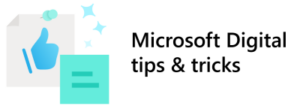 As the leader of the Microsoft Digital Employee Experience team, it’s my responsibility to ensure that Microsoft employees are the most productive and collaborative in the industry. We are stewards of the employee experience, and we obsess over every detail of the online and in-person meeting experience for our employees. From the physical spaces on campus, to the software that enables the experience, to the support model when employees need additional assistance. While reliable, easy-to-use technology is critical to a great meeting experience in this new hybrid world of work, so are the right behaviors. In fact, our research shows that creating an inclusive environment is as important as the hardware, software, and support experience in ensuring productive and effective hybrid meetings.
As the leader of the Microsoft Digital Employee Experience team, it’s my responsibility to ensure that Microsoft employees are the most productive and collaborative in the industry. We are stewards of the employee experience, and we obsess over every detail of the online and in-person meeting experience for our employees. From the physical spaces on campus, to the software that enables the experience, to the support model when employees need additional assistance. While reliable, easy-to-use technology is critical to a great meeting experience in this new hybrid world of work, so are the right behaviors. In fact, our research shows that creating an inclusive environment is as important as the hardware, software, and support experience in ensuring productive and effective hybrid meetings.
Over the last two years, we’ve all had to radically adjust how we meet and collaborate as most information workers transitioned to remote work. Almost overnight, in-person and hybrid meetings moved online. Even daily interactions with colleagues morphed into online meetings, resulting in a 58 percent increase in Microsoft Teams meetings usage at Microsoft. For better or worse, “virtual coffee chats” became the new normal, and the water cooler moved online.
Researchers at Microsoft and across the industry have worked hard to understand the impact of these changes and to determine how to improve meetings so they achieve their purpose through empowered participants. One of these large studies came to an interesting conclusion: the odds of a meeting being rated as effective are two times higher if attendees say the meeting was inclusive, and more than three times higher when attendees feel comfortable participating.
In other words, inclusive meetings are the most effective meetings. Remarkably, as we’ve adjusted to the new normal of remote work, meeting satisfaction at Microsoft increased by 31 points! The primary reason? Prior to the pandemic, remote participants were less likely to be active participants in hybrid meetings. Now that the playing field is leveled, participants report being more comfortable participating in online meetings. Across the company, we’re learning to be more inclusive and meetings are becoming more participatory.
So, how can you make your meetings more inclusive? Here are some practical tips that we’ve learned running remote and hybrid meetings at Microsoft.

1. Limit meeting invites to necessary attendees
Be thoughtful about who you invite to your meeting. Make sure roles are clear and everyone understands why they are there and how they can contribute. Provide a place outside of the scheduled meeting to engage and view the artifacts or bring others into the conversation. Record your meeting and remember that hybrid meetings don’t always have to be a “point in time” exercise—they can be a gathering place for ongoing collaboration, grounded in the initial conversation but extending beyond the original participants and agenda. This is particularly important for teams that span time zones!
2. Keep meetings short
Research shows that remote and hybrid workers experience increased fatigue from too much time spent in meetings. Fatigue begins to increase 30–40 minutes into video meetings, so keep meetings as short as possible—30 minutes max—or plan breaks in the schedule for longer meetings. Starting and ending meetings on time is a significant stress reducer for your attendees. Also, consider a buffer between meetings.
Could you start at five minutes after the hour to give people time to recharge? Or end five minutes early? You can even set up Microsoft Outlook to automatically end meetings early using the “end meetings early” option under File > Options > Calendar > Calendar Options > Shorten appointments and meetings. I’ve made this a requirement for my leadership team meetings—it’s made our meetings more focused and our days a little less hectic!

3. Always provide an agenda!
Agendas appear throughout the available research as an indicator of a meeting’s effectiveness. Meetings without clear agendas contribute to increased frustration and meeting fatigue, while well-run meetings with clear communication are associated with better perceived productivity. You can even implement a more radical policy in your enterprise, requiring an agenda for mandatory meetings or letting your team know that a meeting without a published agenda should be considered optional.
4. Camera shy? Still consider turning on video
In remote and hybrid meetings, sharing video creates rapport with colleagues. Studies have highlighted the importance of observing body language and facial expressions to build positive group dynamics. However, there are some situations where video may not be appropriate, including large meetings (when you aren’t presenting), when bandwidth is poor, and when video contributes to meeting fatigue. For those cases, update your Microsoft 365 profile with a photo or an avatar that represents something about your personality to help other meeting attendees relate to you when you choose not to share video. If the camera isn’t your thing, try making a commitment to start meetings with your camera on to build some rapport, then turning it off once the meeting is underway. And try to relax—you look great on camera!
5. Send pre-reads and follow-ups
Preparation and clear communication are vital in today’s remote and hybrid work environment. Share any tools or files you’ll use during your meeting in advance, along with the meeting agenda. After your meeting ends, immediately send follow-up materials or notes and be sure to record and transcribe the meeting so those who can’t attend synchronously have access. Focus on capturing well-defined action items with owners and due dates, since an action owner in another time zone might not have been able to attend the meeting synchronously.
6. Establish norms
Make a point of establishing participatory norms for the meeting. For example, should attendees raise their hand, unmute, speak up, or use chat when they have questions and comments? Or, if the agenda is tight, would you prefer them to save questions for the end of the meeting? If you expect everyone to turn on video for a face-to-face conversation, state this in your invitation so no one is caught off guard. Also, inform attendees before starting a recording or transcription.
7. Have everyone join the Teams meeting
As more people globally return to worksites, many meetings will likely have a mix of people joining remotely and from a meeting room. Whether employees are joining from home, on the road from their mobile, from their own desk, or together with others in a conference room, they should feel equally included in the meeting.
You can accomplish this by centering your meeting in Teams rather than in the meeting room. Encourage everyone, even those who attend in person, to join the Teams meeting. From there they can participate in chat, use reactions, and raise their hand when they have something to contribute.
8. Make meetings interactive!
It can be challenging to manage a remote or hybrid meeting, but the more interactive the session, the more likely you are to achieve the desired outcome. Once norms are established, be on the lookout for people who come off mute—it’s normally a sign they have something to add. Look for people who raise their virtual hand and keep an eye on the chat window for questions or shared insights, then repeat them for all participants. Depending on the size of the meeting, it may be beneficial to select a moderator to watch for raised hands and questions in the meeting chat then have the moderator facilitate a brief meeting retrospective to ensure participants felt seen and heard. Chats can add depth to a meeting, especially when participants use emojis or GIFs (when appropriate and aligned to local law or custom). Encourage users to express themselves with live reactions. Finally, consider ways to incorporate additional interactive elements, like a Teams Whiteboard, a poll, or through an embedded app. This recent article from Harvard Business Review includes some fun tips to make meetings more engaging that require no technology at all.
While some of these suggestions may seem self-evident, building a culture that routinely and instinctively implements these best practices is challenging. If you’d like additional inspiration, our peers over at the Microsoft 365 blog recently featured a great article detailing seven strategies for building a healthier meeting culture.

Check out Microsoft’s internal Microsoft Teams Meeting guide.
Learn how Microsoft is using Microsoft Teams and ServiceNow to enhance end-user support.
Read how Microsoft is implementing a Zero Trust security model.
Tags: digital transformation, hybrid work, Microsoft 365, Microsoft Teams, remote work








